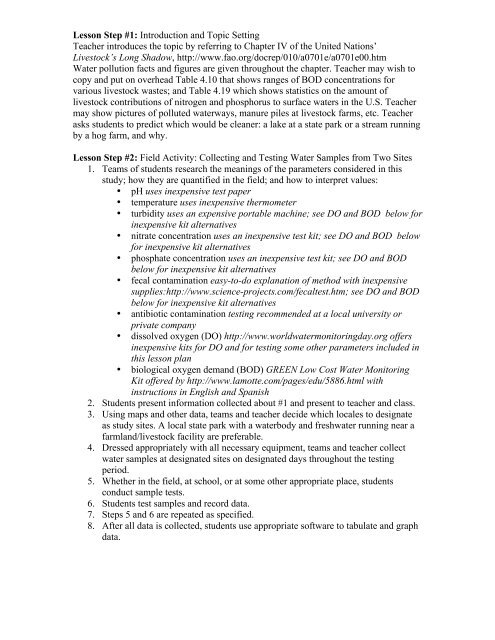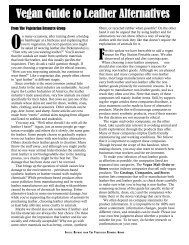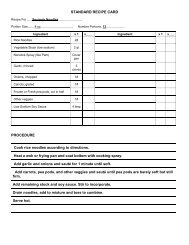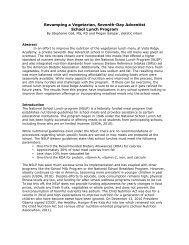LESSON PLAN GRADES 9-12 FOR TEACHERS Lesson Plan: A ...
LESSON PLAN GRADES 9-12 FOR TEACHERS Lesson Plan: A ...
LESSON PLAN GRADES 9-12 FOR TEACHERS Lesson Plan: A ...
Create successful ePaper yourself
Turn your PDF publications into a flip-book with our unique Google optimized e-Paper software.
<strong>Lesson</strong> Step #1: Introduction and Topic SettingTeacher introduces the topic by referring to Chapter IV of the United Nations’Livestock’s Long Shadow, http://www.fao.org/docrep/010/a0701e/a0701e00.htmWater pollution facts and figures are given throughout the chapter. Teacher may wish tocopy and put on overhead Table 4.10 that shows ranges of BOD concentrations forvarious livestock wastes; and Table 4.19 which shows statistics on the amount oflivestock contributions of nitrogen and phosphorus to surface waters in the U.S. Teachermay show pictures of polluted waterways, manure piles at livestock farms, etc. Teacherasks students to predict which would be cleaner: a lake at a state park or a stream runningby a hog farm, and why.<strong>Lesson</strong> Step #2: Field Activity: Collecting and Testing Water Samples from Two Sites1. Teams of students research the meanings of the parameters considered in thisstudy; how they are quantified in the field; and how to interpret values:• pH uses inexpensive test paper• temperature uses inexpensive thermometer• turbidity uses an expensive portable machine; see DO and BOD below forinexpensive kit alternatives• nitrate concentration uses an inexpensive test kit; see DO and BOD belowfor inexpensive kit alternatives• phosphate concentration uses an inexpensive test kit; see DO and BODbelow for inexpensive kit alternatives• fecal contamination easy-to-do explanation of method with inexpensivesupplies:http://www.science-projects.com/fecaltest.htm; see DO and BODbelow for inexpensive kit alternatives• antibiotic contamination testing recommended at a local university orprivate company• dissolved oxygen (DO) http://www.worldwatermonitoringday.org offersinexpensive kits for DO and for testing some other parameters included inthis lesson plan• biological oxygen demand (BOD) GREEN Low Cost Water MonitoringKit offered by http://www.lamotte.com/pages/edu/5886.html withinstructions in English and Spanish2. Students present information collected about #1 and present to teacher and class.3. Using maps and other data, teams and teacher decide which locales to designateas study sites. A local state park with a waterbody and freshwater running near afarmland/livestock facility are preferable.4. Dressed appropriately with all necessary equipment, teams and teacher collectwater samples at designated sites on designated days throughout the testingperiod.5. Whether in the field, at school, or at some other appropriate place, studentsconduct sample tests.6. Students test samples and record data.7. Steps 5 and 6 are repeated as specified.8. After all data is collected, students use appropriate software to tabulate and graphdata.
















